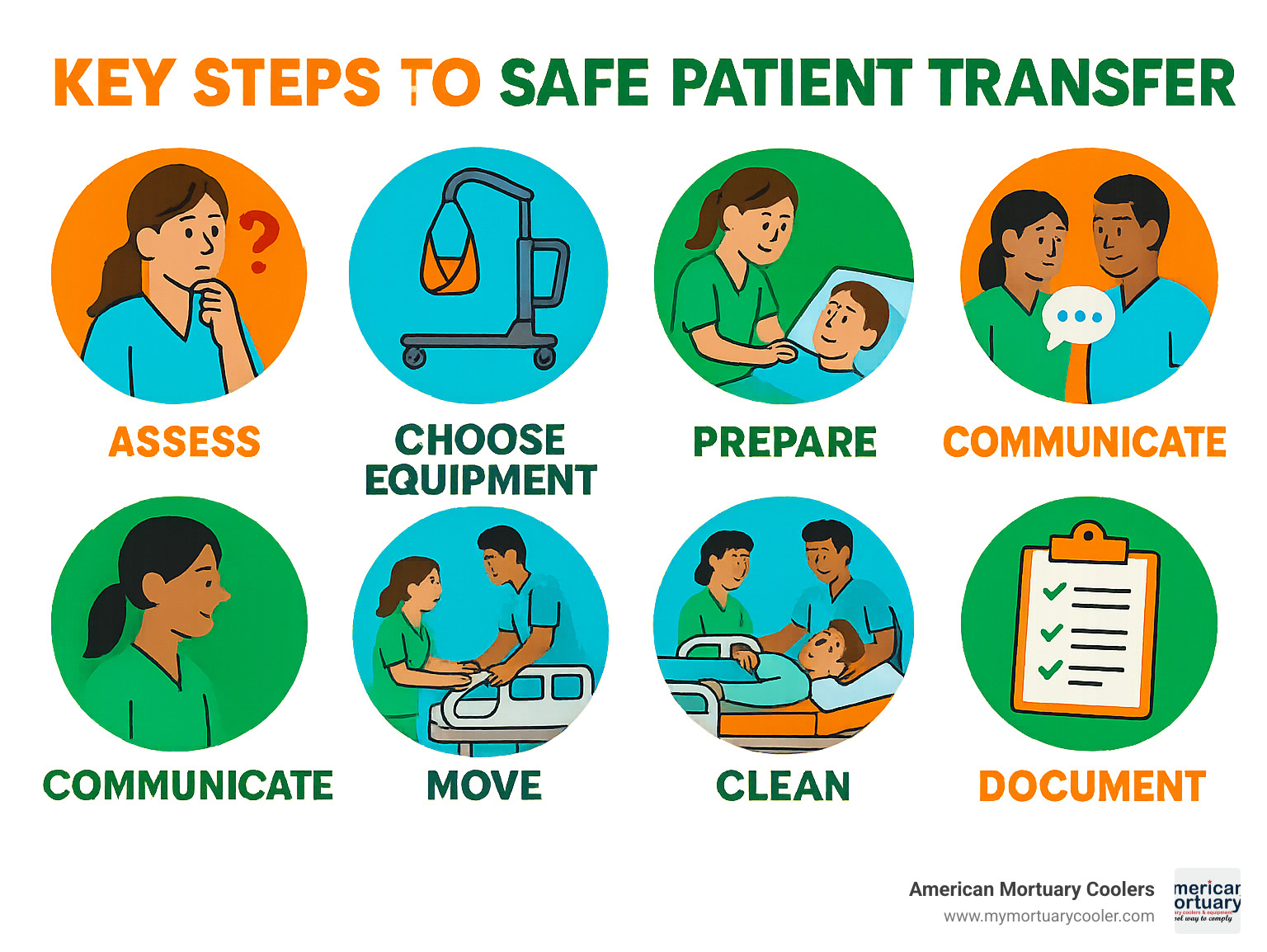Patient Mover Equipment: Fast Answers for Safe & Easy Transfers
A patient mover is any device that helps safely transfer patients—living or deceased—from one surface to another, such as from a bed to a stretcher, chair, or mortuary cart. Designed to reduce strain on caregivers and protect patients, patient mover equipment includes slide sheets, transfer boards, sit-to-stand aids, mechanical lifts, and portable stretchers. These tools are essential for minimizing lifting injuries (nursing assistants face injury rates five times higher than most jobs) and for smooth, secure, and hygienic moves in medical, emergency, and mortuary settings.
Quick Reference: What is a Patient Mover?
- Definition: Equipment used to transfer patients safely between surfaces
- Main Types: Slide sheets, transfer boards, soft stretchers, sit-to-stand aids, motorized lifts
- Key Benefits: Prevent caregiver injury, improve patient comfort, support infection control
- Weight Limits: From 300 lbs (basic boards) to 1800 lbs (bariatric soft stretchers)
- Settings: Hospitals, rescue scenes, care homes, morgues, funeral homes
"Designed to assist in the transport and rescue of patients from areas that are difficult to access with traditional stretchers."
I'm Mortuary Cooler, a national supplier specializing in patient mover equipment and mortuary stretchers, helping funeral homes and EMS teams find durable, American-made solutions for safe, reliable transfers.

Patient mover terms simplified:
What Is a Patient Mover?
A patient mover is any piece of equipment designed to make transferring a person from one surface to another safer and easier—think sliding a patient from a bed to a stretcher, or gently lifting from a chair to a mortuary cart. The heart of every patient mover is its mission: protect both the caregiver and the patient, reducing the risk of back injuries, pressure sores, and even infections during moves.
There’s a surprising variety of patient movers out there. You’ll find everything from simple slide sheets for smooth side-to-side (lateral) transfers, to powerful motorized lifts that can gently raise a patient up and down, to tough, portable soft stretchers made for emergency evacuations or tight spaces. In fact, these tools are so important that OSHA now recommends them as a best practice to fight the sky-high rates of musculoskeletal injuries among caregivers. For patients, comfort matters just as much—no one likes bumps, pulls, or awkward “scoots.”

Independent Patient Mover Methods
Not every transfer needs a big, fancy device. If a patient is able to help out—even a little—transfers get a lot simpler. Here’s where independent patient mover methods shine. Gait belts are a favorite: sturdy belts that give caregivers a safe grip while the patient uses some of their own strength. Sometimes, all it takes is a little “minimal assist,” where you offer support and the patient does most of the work themselves. And never forget good old body mechanics: both caregiver and patient use smart posture, bend those knees, keep the load close, and move smoothly together. If a patient can stand, follow directions, and bear most of their weight, tools like gait belts or basic slide boards are your go-to.
Dependent Patient Mover Scenarios
But what if a patient can’t help at all? For folks who are immobile, unconscious, or need bariatric care, “independent” methods just aren’t enough. Here’s where dependent patient mover devices come in. Mechanical lifts—like floor lifts or ceiling track systems (think Hoyer lifts)—take over the heavy load. For tough environments or narrow hallways, soft stretchers (like the MegaMover) are lifesavers, built for rescue and fast action. And when you need serious power, motorized movers like the MediGLIDER can handle big weight with just one caregiver using a simple joystick. Imagine moving a 500-lb patient by yourself—no sweat, no sore back.
Real-world story: After one hospital dealt with a painful staff injury during a surgical table transfer, they switched to the MediGLIDER. Over ten years, both staff and patients saw fewer injuries, and transfers became quicker and less stressful.
No matter the situation, the right patient mover keeps everyone safer, more comfortable, and ready for what’s next.
Types & Use-Cases of Patient Movers
When it comes to patient mover equipment, there’s truly something for every situation—whether you’re in a busy hospital, a remote rescue scene, or a funeral home. The right tools make all the difference for safe, smooth transfers and happier caregivers.
You’ll find slide sheets that let you glide patients sideways on beds with barely any effort, and transfer boards that act as sturdy bridges—think bed to wheelchair, or stretcher to exam table. For those who just need a little help getting upright, sit-to-stand aids give patients a boost with extra support, while mechanical lifts tackle the heavy lifting (literally). And don’t forget the unsung heroes: soft stretchers and motorized movers, built for big jobs, tight spaces, and serious weight.
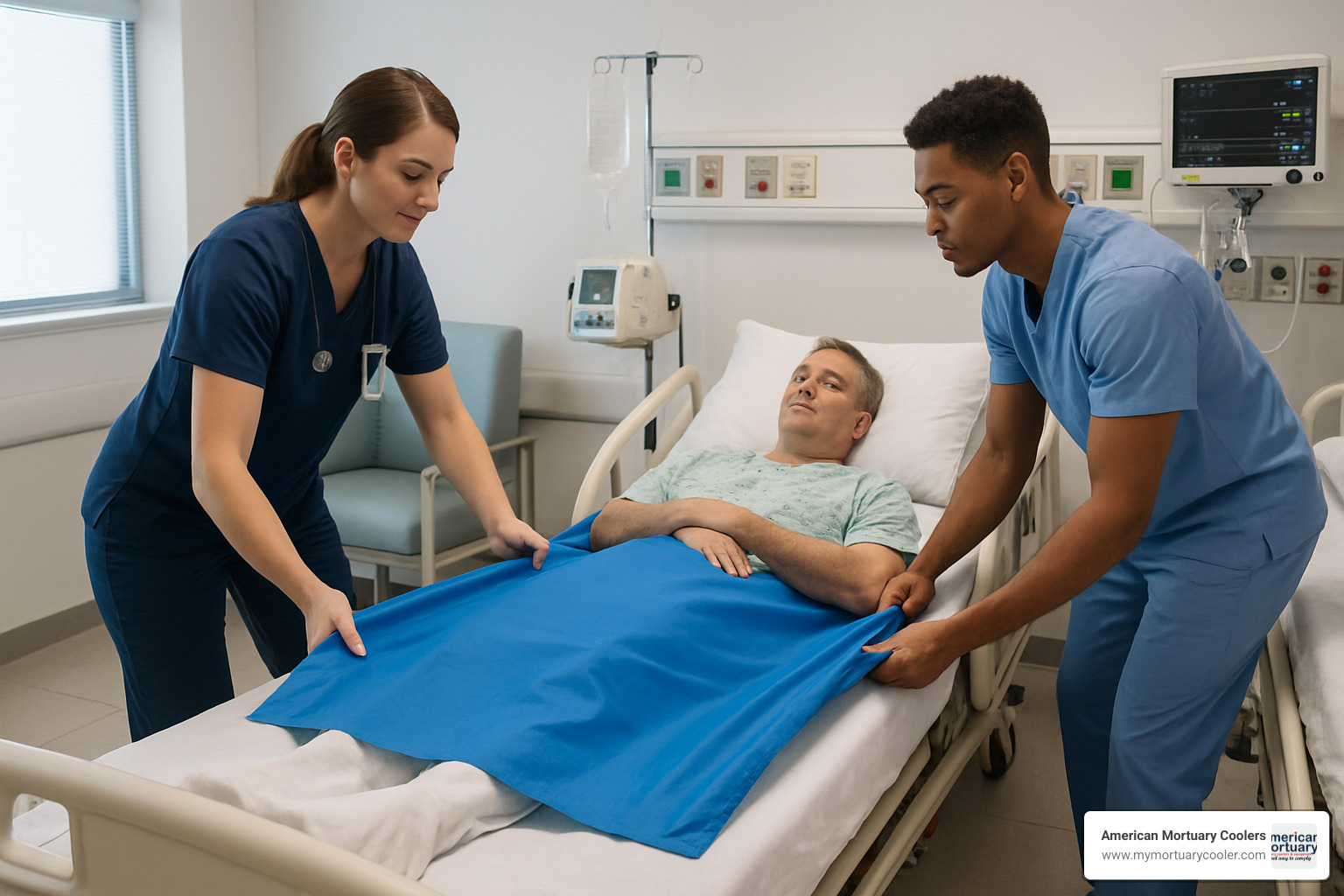
Let’s walk through the main types and where they shine:
Slide Sheets & Transfer Sheets
Slide sheets are like magic carpets for caregivers. Made from low-friction materials, they let you move patients sideways on a bed or table with almost no tugging or straining. Some, like the Slipp® device, even use a slick fluid layer inside for extra glide. These come in washable, reusable, or disposable styles, and many help keep things hygienic thanks to fluid barriers and easy cleaning.
They’re best when you need to move someone laterally—like from one side of a bed to another, or onto a mortuary table. Standard sheets can handle most adults, but bariatric versions are made for heavier patients.
Transfer Boards & Shifters
When you need to bridge a gap, grab a transfer board. These semi-rigid planks—like the Shifter or PATSLIDE—let patients slide from a bed to a chair, or chair to a wheelchair, without standing up. Made from strong, lightweight polyethylene, they usually have handles to keep your knuckles safe. There are even latex-free options for sensitive skin.
Transfer boards are perfect for patients who can help a bit with their arms, making those tricky “bed-to-chair” moves much safer and easier for everyone.
Sit-to-Stand Patient Mover Aids
Sit-to-stand aids give patients the extra support and confidence they need to rise from a seat. Tools like the QuickMove or patient turners are sturdy and adjustable, often with knee-braces and cushioned supports. These devices allow patients to help themselves—while reducing the chance of falls or back injuries for caregivers.
Sit-to-stand movers work well in rehab settings, long-term care, and at home—especially when you want to support independence and dignity.
Mechanical & Motorized Patient Movers
If the move is heavy or complex, mechanical and motorized patient movers step in. Classic options like Hoyer lifts (available in portable or ceiling-mounted models) use a sling to safely lift patients vertically. For more muscle, the MediGLIDER uses a motor and joystick—one person can move a 500-lb patient with a single finger! The Transtrack adds a rolling platform for easy lateral transfers.
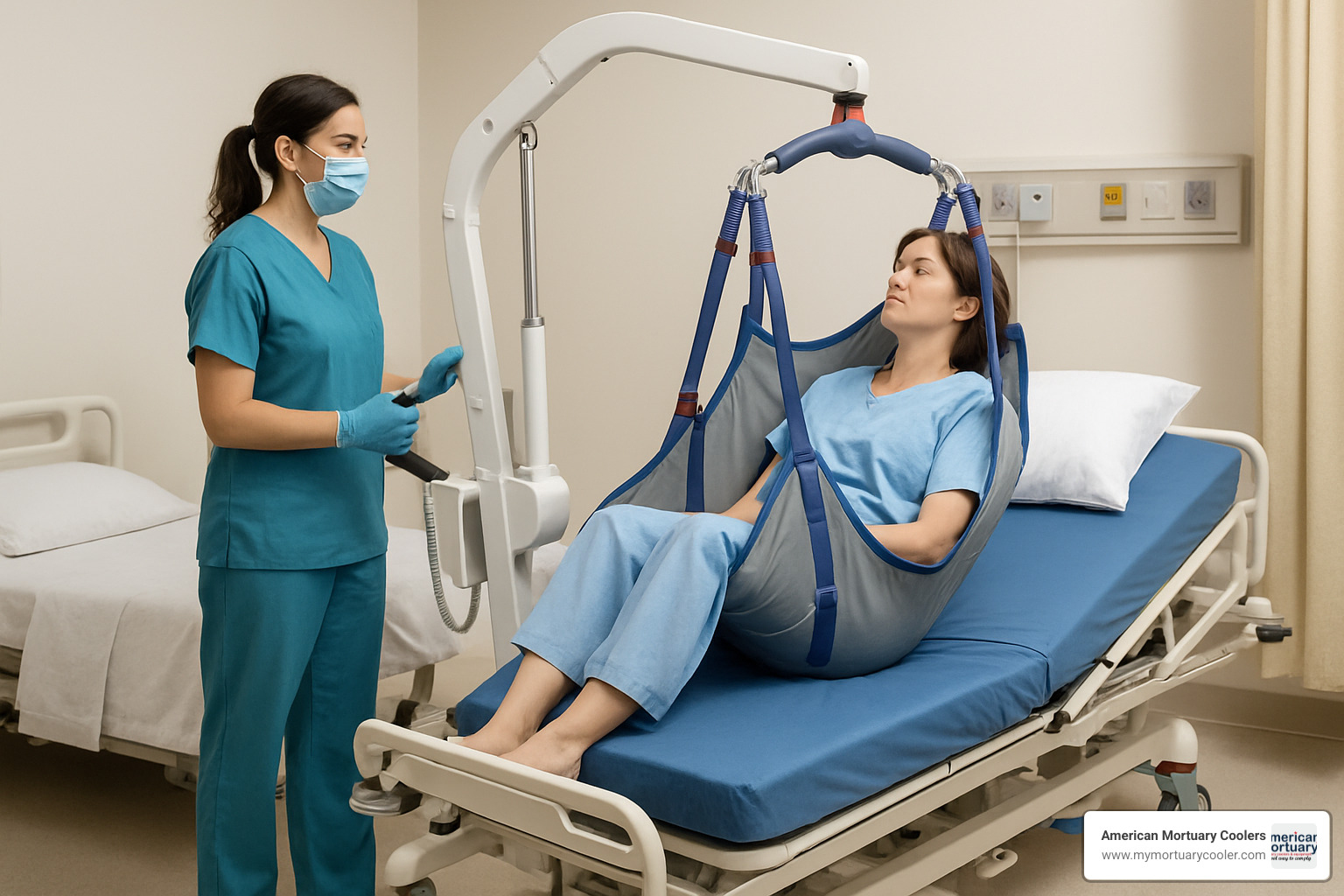
These solutions are a lifesaver in situations where staff are limited, or patients are too heavy or fragile to move by hand.
Soft Stretchers & Portable Evacuation Units
For emergencies, tricky spaces, or bariatric patients, soft stretchers and portable evacuation sheets shine. The MegaMover weighs just a pound, but holds up to 1,000 lbs! It folds tiny, so you can stash it anywhere, and its 14 handles let a team share the load. The Advanced Patient Mover is even tougher—fluid-proof, washable, and rated for up to 1,800 lbs.
EMS crews, rescue teams, and mortuary professionals rely on these for everything from mountain trail rescues to tight apartment stairwells. When wheels won’t work, these stretchers get the job done—no hero capes required.
No matter your setting—hospital, EMS, or funeral service—the right patient mover keeps everyone safer and transfers smoother. If you’re looking for more specifics or want to dive into unique products, check out A Comprehensive Guide to Buying the MegaMover EMS for First Responders for an in-depth look at one of the best portable solutions out there.
Safety, Infection Control & Best Practices
Let's talk about the heart of patient care - keeping everyone safe. Safe patient handling isn't just about having fancy equipment in your closet. It's about knowing how to use it properly, keeping things clean, and protecting both the caregiver and the patient throughout the process.
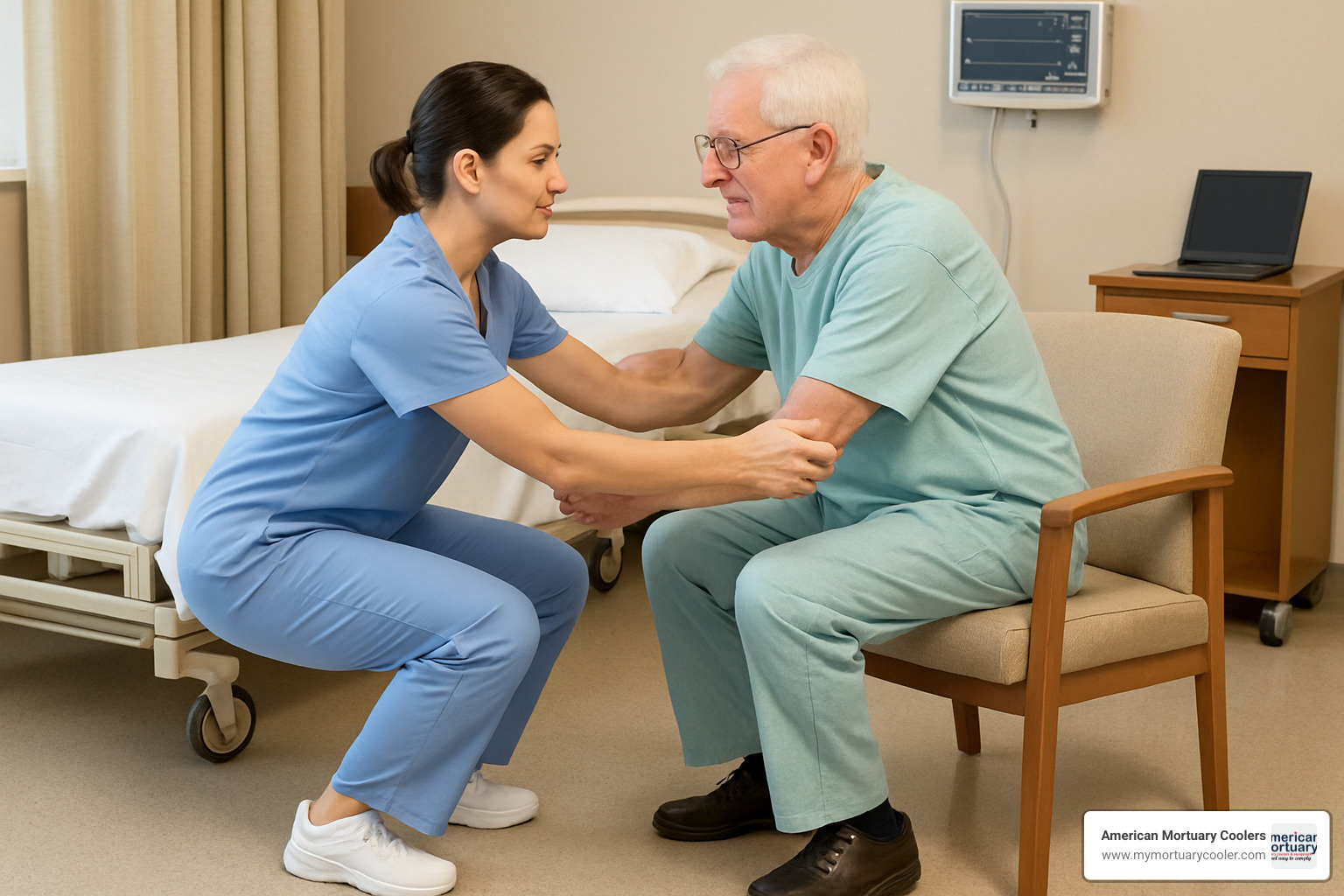
Preventing Caregiver Injury
Did you know nursing assistants are getting hurt on the job at a shocking rate? They lose workdays to musculoskeletal injuries five times more often than workers in other fields. That's why tools like the patient mover aren't just nice-to-haves – they're essential protections.
The MegaMover and PATSLIDE are designed with multiple handles positioned strategically around the device, giving caregivers better leverage and control. Those non-skid surfaces aren't just for patient safety – they help you maintain proper positioning without extra strain.
Both the FDA and OSHA have looked at the data and reached the same conclusion: using proper patient mover equipment significantly reduces the risk of career-ending back and shoulder injuries.
As one PATSLIDE user put it: "It not only makes the job easier and safer, but also reduces the risk of injury to nursing staff." Your back will thank you later!
Want to dig deeper? Check out the Scientific research on safe patient handling from OSHA's healthcare resources.
Protecting Patients with Medical Equipment
Moving patients with medical attachments takes extra care and attention. I remember watching a skilled nurse manage a complex transfer of a post-surgical patient – it was like watching a choreographed dance with all those tubes and lines!
Before any transfer begins, always check and secure all lines. This simple step prevents accidental disconnections that could lead to complications. For catheters and drainage tubes, keep them positioned below the body cavity to prevent dangerous backflow of fluids.
Oxygen tubing and IV lines need special attention too. Avoid any kinking or pulling during the transfer – a gentle coiling technique works wonders. And of course, maintain proper aseptic technique with gloves and appropriate barriers throughout the process.
A hospital I worked with shared a success story using the MediGLIDER for a trauma patient with multiple chest tubes. The smooth, controlled movement minimized skin shear (a major concern for fragile patients) and kept all tubes secure – with fewer staff members needed than a traditional transfer.
Hygiene & Infection Control
In today's healthcare environment, infection control is non-negotiable. The good news? Modern patient mover equipment is designed with this in mind.
Many soft stretchers like the Advanced Patient Mover feature fluid-impervious materials that prevent body fluids from soaking in. After use, they can be thoroughly washed and air-dried, ready for the next patient.
For extra protection, consider disposable covers like MediGAARD sheets. These create a single-use barrier that limits cross-contamination between patients – particularly important in high-risk situations or during infectious disease outbreaks.
Most quality slide sheets and soft stretchers are machine-washable, making regular cleaning simple. Just check the manufacturer's instructions for specific temperature recommendations.
One note of caution for our California friends: some plastic-based patient movers contain chemicals flagged under Proposition 65. If your facility has specific compliance requirements, always check product specifications before purchasing. At American Mortuary Coolers, we're happy to provide this information for any equipment we supply.
Buying Guide: Costs, Comparisons & Latest Innovations
Let's have an honest chat about what matters most when shopping for a patient mover - your budget, what you need it to do, and the cool new features that might make your life easier.
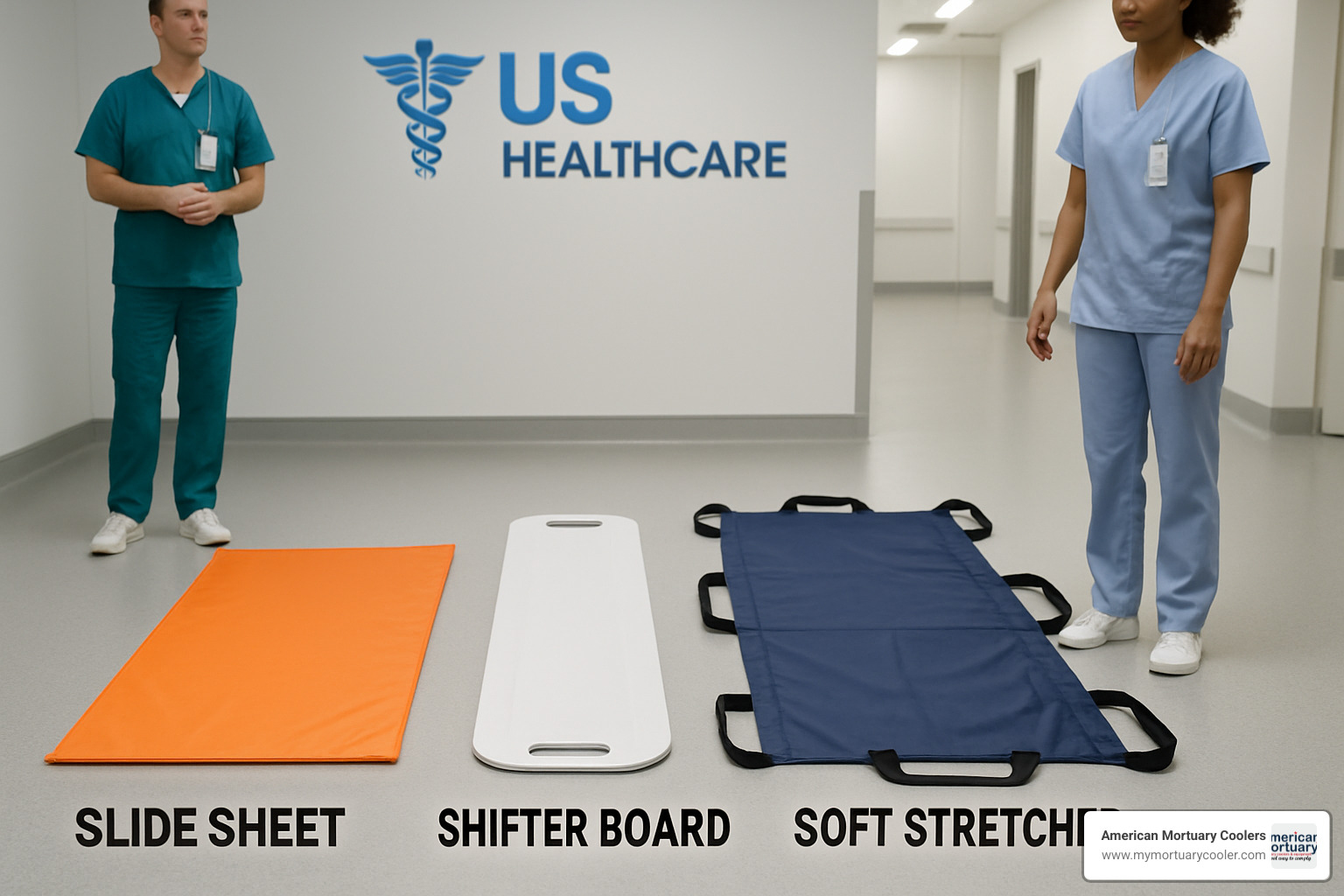
Budget-Friendly Patient Mover Options
Not every facility needs to break the bank to get reliable transfer equipment. If you're watching your pennies (and who isn't these days?), several excellent options won't drain your budget.
The trusty Slipp® slide sheets are a fantastic starter option in the $100-$300 range. They're lightweight (under 3 pounds), latex-free for those with sensitivities, and you can toss them in the washing machine after use. For a bit more structure, the Shifter Board runs about $200-$400 and handles up to 400 pounds while remaining semi-rigid for those tricky transfers.
My personal favorite budget-friendly option has to be the MegaMover Plus. For $114-$396, you get an incredibly versatile soft stretcher that weighs just one pound but can support a whopping 1,000 pounds. Talk about getting bang for your buck!
When funds are tight, slide sheets and transfer boards give you the most versatility for your dollar. They might not be fancy, but they get the job done reliably day in and day out.
Premium Motorized Solutions
For facilities handling frequent transfers or regularly working with heavier patients, investing in motorized solutions can be a game-changer for your staff's wellbeing.
The MediGLIDER stands out with its intuitive joystick control that lets a single caregiver safely move patients up to 500 pounds. Its battery lasts an impressive 14+ hours and can handle about 40 transfers on a single charge. No more hunting for an outlet mid-transfer!
The Transtrack system offers another premium option with its rolling mechanism that works across multiple platform types, making it incredibly versatile for different department needs.
Yes, these motorized options have a higher price tag upfront, but let's talk return on investment. When you factor in reduced staff injuries, decreased overtime costs, and fewer workers' compensation claims, many facilities find these premium solutions actually save money in the long run. One hospital administrator told me they recovered their investment in just eight months through reduced injury-related costs.
See also: A Comprehensive Guide to Buying the MegaMover EMS for First Responders
How to Read Weight Capacity Labels
Understanding weight ratings is crucial for safety, but manufacturers don't always make it crystal clear. Here's the straight talk:
Standard transfer boards typically handle 300-400 pounds, which works for most everyday situations. When you need more capacity, look to bariatric-rated equipment like the Advanced Patient Mover and MegaMover, which confidently support 1,000-1,800 pounds.
Here's a pro tip I always share with our customers: Always choose equipment rated higher than your heaviest patient. This built-in safety factor accounts for movement during transfers and any additional equipment the patient might have. Better to have too much capacity than too little when someone's safety is on the line!
| Device | Type | Weight Capacity | Notable Features | Price Range |
|---|---|---|---|---|
| MegaMover | Soft stretcher | 1,000 lbs | 14 handles, foldable, 1 lb | $114–$396 |
| PATSLIDE | Transfer board | <400 lbs* | Non-skid, X-ray translucent, flexible | $200–$400 |
| MediGLIDER | Motorized | 500 lbs | Joystick, infection control, battery | $$$$ |
| QuickMove | Sit-to-stand aid | 375 lbs | Adjustable, modular accessories | $400–$2,000 |
*Check with manufacturer for bariatric models
At American Mortuary Coolers, we understand that each facility has unique needs. That's why we're happy to help you compare options and find the patient mover that balances your budget, capacity requirements, and feature wishlist. We've been helping funeral homes, hospitals, and EMS teams find the perfect transfer solutions for years, and we're just a phone call away when you're ready to explore your options.
Care, Training & Compliance
Bringing a patient mover into your facility is just the beginning of your journey—think of it as adopting a new team member that needs proper care and understanding to perform at its best. Let's talk about how to keep your equipment in top shape and your team ready for action.
Routine Cleaning & Storage
After a long day of transfers, your patient mover deserves some TLC. Give it a thorough wipe-down with detergent wipes after each use—especially important when bodily fluids have been involved. Then let it air-dry completely before storing it away. This simple step prevents the growth of mildew and extends the life of your materials.
Many of our customers keep inspection logs right next to their equipment storage area. A quick weekly check for tears, worn straps, or damaged parts can prevent an equipment failure when you least expect it. Most soft stretchers like the MegaMover fold neatly into backpacks or duffel bags—perfect for keeping them clean and ready for rapid deployment when every second counts.
"We hang our MegaMover in the ambulance bay, always ready to go," shares one EMS director. "After cleaning, we run through a quick 7-point inspection before refolding it—hasn't failed us yet in three years of service."
Mandatory Training for Patient Mover Use
Even the best equipment is only as good as the hands that use it. Most patient mover products come with training resources—Slipp® includes an 8-minute in-service DVD that's worth its weight in gold (and saved backs!). Make watching these videos mandatory before first use.
Beyond initial training, supervisors should regularly observe staff performing transfers and gently correct any slipping body mechanics. We've seen the best results when facilities incorporate quick practice drills during slower periods. As one nursing director told us, "We do 'Transfer Tuesdays' with practice scenarios. Since starting this, our workplace injuries have dropped by almost 30%."
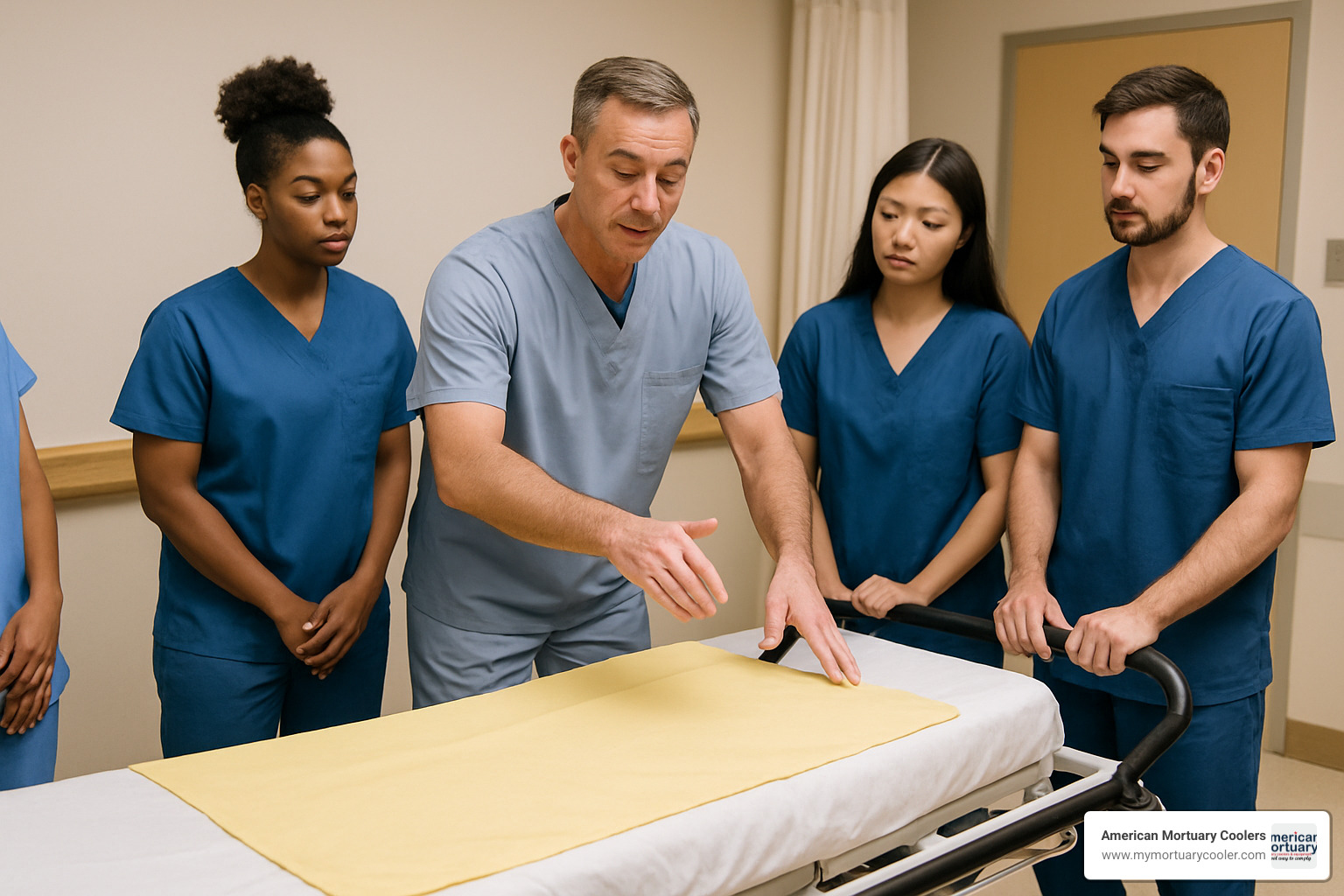
Regulatory & Ethical Considerations
The paperwork side of patient mover equipment matters too. Always look for FDA and CE marks on your devices—these certifications confirm they meet healthcare standards. For living patients, explaining the transfer process and getting their consent isn't just good bedside manner—it's an ethical requirement that builds trust.
OSHA compliance isn't optional in healthcare settings. Using approved patient movers often satisfies workplace safety requirements and helps avoid potential citations. If you're in California, be aware of Prop65 material disclosures that may apply to certain plastic components.
Here's something many facilities don't realize: in some regions, disabled or chronically ill patients can claim VAT relief on transfer aids purchased for home use. Sharing this information with families can make a meaningful difference in their ability to afford quality equipment.
"We always recommend documenting which transfer device was used in patient charts," suggests a risk management consultant. "It demonstrates your commitment to safe handling practices if questions ever arise."
For more specialized information on equipment selection, check out our guide on Medical Stretcher vs Mortuary Stretcher: Understanding the Heavy Duty Differences.
At American Mortuary Coolers, we don't just sell equipment—we partner with you to ensure your team has everything needed for safe, dignified transfers every time. Our Tennessee craftsmen build durable solutions that stand up to years of service with proper care and handling.
Conclusion
When it comes to safely moving patients with dignity and care, having the right equipment makes all the difference. At American Mortuary Coolers, we've dedicated ourselves to creating patient mover solutions that protect both caregivers and those in their care.
From our home base in Tennessee, we craft custom-built, durable equipment that stands the test of time—whether you're in a busy Los Angeles emergency room, a New York hospice facility, or a family-owned funeral home in Dallas. Our commitment to quality means every transfer can be accomplished with confidence and respect.
Safer transfers aren't just a goal—they're our promise. That's why we deliver directly to all 48 contiguous states, ensuring your facility has exactly what you need, when you need it.
The right patient mover doesn't just prevent injuries—it preserves dignity, speeds recovery, and helps your team work more efficiently. Whether you're looking for budget-friendly slide sheets or investing in advanced motorized solutions, we're here to guide you toward equipment that fits your specific needs.
For those wanting to dive deeper into our complete lineup of transfer solutions, take a moment to explore our detailed equipment guide. You'll find specifications, maintenance tips, and real-world applications that can transform your patient handling protocols.
Ready to make every transfer safer? Our team is just a call away—whether you're connecting with our specialists in Johnson City, Atlanta, Chicago, or any of our regional offices. We're not just selling equipment; we're partnering with you to create safer environments for everyone involved in the transfer process.
After all, at the heart of every patient mover is a simple truth: we're all human, caring for humans, and deserving of tools that make that care as safe and compassionate as possible.
